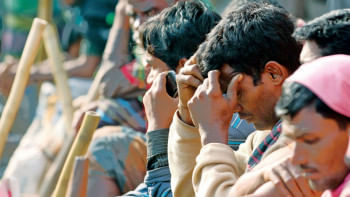Contextualising mental health in Bangladesh: The youth perspective

Mental health has traditionally been a taboo subject in Bangladesh, frequently overlooked at the policy level. The country undertook its first-ever National Mental Health Policy 2022 this June, which is highly appreciated. The mental healthcare issue is one of the crucial targets of the SDG 3 (Health and Wellbeing: Ensure healthy lives and promote well-being for all at all ages). The target mentions: "By 2030, reduce by one third premature mortality from non-communicable diseases through prevention and treatment and promote mental health and well-being."
Among the health-related issues that the SDGs talk about, suicide comes directly among the 13 topics, and several other topics cover mental health. At a global level, one of the largest disease burdens in 2017 came from mental and substance use disorders at five percent. While the SDG-related official website, "Our World in Data," observes that mental and substance use disorders form the top four health burdens across many upper-middle and high-income nations – in contrast to low-income or lower-middle income ones such as Bangladesh – it can be easily argued that lack of reported events of mental health issues are not proof of lower level of burden. Rather, it is simply an ignored issue in these countries, where healthcare is a luxury itself, and mental health care is costly and often stigmatised.
Bangladesh's National Budget for FY 2022-23 mentions the mental health care issue as part of an "In addition," where it explains the plan in one line: "The project for the development and expansion of Pabna Mental Hospital to international standards and the establishment of full-fledged mental health unit at every divisional level medical college are going to be taken up." Furthermore, the budget envisions a plan to establish Bangabandhu Health City at Mohakhali in the capital, where it might be assumed that mental health care will be a sub-section, regardless of size. The budget does not mention a specific allocation for mental health, which is nothing new for a traditional budgetary document. For instance, if someone looks for similar data in past observable budget speeches (that is, publicly available ones online), the disaggregation is mostly absent, showing the level of importance mental health care is being given by the respective authorities entrusted with the financial blueprint of the year. The mental health budget was specifically mentioned in the 2020-21 budget, with only 100 crores in allocation, which was still a result of pandemic-related public concerns regarding mental health. As praiseworthy as it was as a starting step, the continuation of that effort has been absent, at least in budget speeches.
National Mental Health Policy 2022 is an adequate document in terms of contextualising the mental health scenario of Bangladesh. According to the document, the budgetary allocation for mental health is, on average, barely 0.5 percent of the total health sector budget. As always, the policy document seems promising, but requires strong implementation, monitoring, and evaluation of progress.
The country has been riddled with suicides, albeit from apparent "successful" or "youth" cohorts, who are dying due to mental health issues stemming from the socio-economic reality that is crippling the younger generation. Unfortunately, what society does not understand – as proven by the floods of Facebook statuses after one dies – is that the kind of talk or intervention required to prevent suicides is not realistically available. Not in the family, and not among surrounding friends and acquaintances.
Suicidal thoughts indicate a critical mental health condition, requiring serious and unstigmatised interventions, medically. As we have learnt to accept allopathy over homeopathy or herbal solutions (the latter of which may work in the long run), societal and informal interventions are far less effective in dealing with one's suicidal tendencies.
Unfortunately, only Dhaka University has a department named Educational & Counselling Psychology, where therapists are being produced each year, albeit their number is far less than what would be optimal, and providing mostly private solutions, meaning it would be costly for a low-income or lower-income household to avail mental health care facilities.
Furthermore, the level of stigma around the apparent solutions provided in universities are neither confidential enough, nor convenient due to the information gap among students, teachers, and everyone else. After all, nobody wants to be labelled a "cuckoo," and many people think that they need to be suicidal to access help, which should never be the case.
Psychotherapy has the ability to help everyone, according to their necessity, and the stigmatisation of mental health care needs to be eradicated by those at the upper portion of the pyramids. Teachers and parents need to speak more openly and share their stories with young people to encourage them to get help. As in the fictional Hogwarts, help should always be given to those who ask for it.
Eshrat Sharmin is a senior research associate at Sanem. Email: [email protected]

 For all latest news, follow The Daily Star's Google News channel.
For all latest news, follow The Daily Star's Google News channel. 







Comments